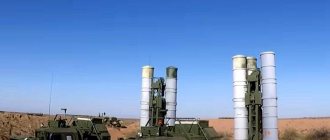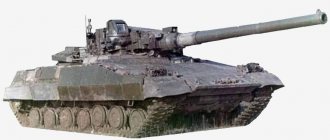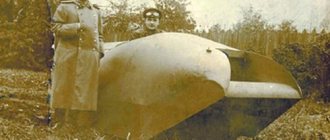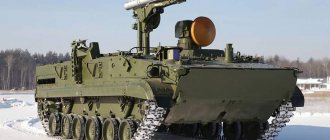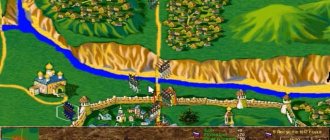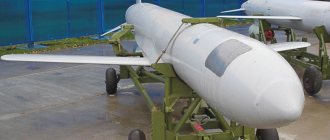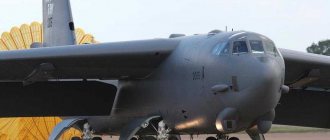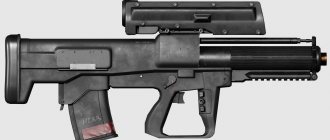Pistol anti-tank missile
ATGM
| 9M119 Svir / 9M119M Reflex AT-11 Sniper | |
| Version 9M119F1 | |
| Type | ATGM |
| Place of origin | Soviet Union |
| Service history | |
| In service | 1980s to present |
| Used | Russia China India Serbia South Korea |
| Production history | |
| Designer | Tula Mechanical Engineering Design Bureau (Tula KBP) |
| Developed | 1980s |
| Manufacturer | Plant named after Degtyareva |
| Unit cost | US$37,500 (2012)[1][2] |
| Produced | 1980s to present |
| Options | 9M119M |
| Characteristics | |
| Weight | 16.5 / 17.2 kg [3] |
| Diameter | 125 mm |
| Warhead | Tandem hollow charge |
| Warhead weight | 4.5 kg |
| Operating range | 4,000 / 5,000 m |
| Maximum speed | Subsonic |
| Guidance system | Riding on a laser beam |
| Launch platform | 125 mm smoothbore guns |
9M119 Svir
The 9M119M
Reflex [ 4] are laser beam-riding, guided anti-tank missiles developed in the former Soviet Union.
The two missiles are similar, but differ in range and launch platform. Both are designed to fire 125 mm smoothbore tank and anti-tank guns (2A45, 2A46 and 2A46M). Their NATO reporting name is AT-11 Sniper
.
The name Svir
comes from the Svir River, and
Reflex
means reflex. The 9M119 replaces or supplants the 9K112 Kobra.
Reflex [edit]
In Reflex
launched through the guns of the T-90 and Serbian M-84AS and some versions of the T-80 and T-84 tanks.
It was also produced by the People's Republic of China for use with the Type 99 tank. [5] The Indian Ministry of Defense has signed a contract with Bharat Dynamics Limited (BDL), a public sector company under the Ministry of Defense Production, to supply Invar anti-tank guided missiles to the Indian Army. BDL produces these missiles in technical cooperation with Rosoboronexport. [6] The 2A45 Sprut-B. anti-tank gun can also be fired. [7] Invar 9M119M and Invar 9M119M1 (Invar-M) fire from a 125 mm cannon. It is ejected by the 9X949 ejection device and the rocket engine is ignited after the rocket exits the barrel. Air from the cylinder, collected by air intakes in the nose, is used to provide movement of the control stabilizers. [ citation needed
] The 17.2 kg (37.8 lb) missile is 690 mm (27.1 in) long and has retractable stabilizers (with a girth of 250 mm/69) to aid in guidance. The missile is guided by a modulated laser beam controlled by the tank gunner. The missile has a maximum flight range of 5,000 meters at a speed of 350 meters per second (maximum flight time of 17.69 seconds). Invar allows the tank to hit targets at twice the range of 125mm shells. The tandem warhead can penetrate up to 900 mm (35.4 in) of armor. The 9M119M Invar missile was put into service in 1992, and the 9M119M1 Invar-M missile in the second half of the 1990s. [8] [9] High-explosive versions 9M119F and 9M119F1 are also produced, which are designed to destroy enemy personnel. [10]
“Svir”, “Reflex” and “Rupture”
“Svir”, “Reflex” and “Rupture”
No logical constructions can explain the long-term simultaneous serial production of three types of main tanks in the USSR, but this fact itself to some extent explains how the dear Fatherland reached its current state.
T-72 with the 9K120 "Svir" complex
In a family of tanks with very similar characteristics, the T-72 was to some extent similar to the youngest member of the family from that very fairy tale, where of the three brothers “the eldest was the smart one...”. One way or another, the T-72 was intended for the most mass production according to the principle - “more in number, cheaper in price.”
But that’s not the only reason why the T-72, unlike other fourth-generation tanks, was not equipped with a guided weapon system. The use of Cobra on T-72 tanks was also hampered by their technical features. As is known, the rocket of this complex was operated in the form of two blocks, which were automatically docked when the gun was loaded. At the same time, a certain orientation of the Cobra blocks was required, which was ensured by using automatic loaders with a “basket” type conveyor installed on tanks of the T-64 and T-80 families. On tanks of the T-72 type with a different automatic loader - with a carousel-type conveyor - the Cobra complex was not used.
In addition, along with 125-mm tank guns, our country also developed similar anti-tank guns - the towed 2A45 Sprut-B and the self-propelled 2S25 Sprut-S. The general design of these guns, in principle, allowed the use of Cobra missiles, but modifying its ground equipment to meet the requirements of operation in a towed version was a rather difficult task.
The success of the development of the Kastet complex determined favorable prospects for the creation of a 125-mm caliber guided weapon system unified with it. At the same time, the most appropriate solution seemed to be to ensure the unification of ground-based equipment when creating a new rocket, and not to develop another sleeve and support belts for the 9M117 rocket. The significantly larger size of the projectile for 125 mm guns made it possible to significantly increase armor penetration, which for shaped charges increases in proportion to the caliber. Despite the additional difficulties and costs, they nevertheless decided to implement this opportunity, since at that time there was a tendency to repeatedly increase the protection of tanks of potential enemies through the use of multi-layer armor and dynamic protection. In addition, the 9M117 missile, due to its large length, could not be used in 125-mm tank guns with automatic loaders for separate-loading ammunition.
The development of a new complex of 125-mm caliber guided weapons provided for its use both on fourth-generation main battle tanks and in anti-tank artillery. True, the new tanks, with the exception of the T-72, were already equipped with the Moscow design bureau. The same team carried out work to create a modernized version of the Cobra - the Agona complex.
125 mm ATGM
However, the new complexes with laser beam guidance developed by the Tula KBP were distinguished by higher noise immunity. To counter second-generation anti-tank systems with semi-automatic control, the use of various means of creating optical interference was envisaged - from simple illumination with a spotlight to the use of specially created means such as the domestic Shtora system. They were supposed to blind or misinform ground-based equipment designed for automatic direction finding of the missile based on a light or infrared radiation source installed on it. Laser beam guidance systems did not need information about the coordinates of the missile. The laser beam directed at the target entered the receiver mounted on the missile, oriented in the direction opposite to the target and, accordingly, insensitive to interference from the enemy. In addition, for the equipment of complexes with laser beam guidance to a target, it was possible to achieve a significant reduction in the weight-dimensional characteristics and cost of the equipment.
T-80U tanks with the 9K119 “Reflex” complex
Based on this, by the beginning of the eighties, the development of the 9K120 “Svir” complex intended for the main battle tank T-72, as well as its more advanced version 9K119 “Reflex” for the T-80, was underway.
The Svir complex intended for the T-72 was closer in design to the previously created Bastion and Sheksna and did not ensure the use of weapons while the tank was moving, and the maximum range was limited to 4 km. The more advanced Reflex complex ensured firing from a moving tank and hitting targets at ranges of up to 5 km.
125-mm shot of the Reflex complex
However, if the ground-based equipment of the complex had a certain degree of continuity with already proven weapons, the 9M119 missile and, in general, the ZUBK14 separate ammunition round were a completely new and very original product.
Based on the progress achieved in electronics and rocketry over the decade since the start of work on the Cobra, Tula designers were able to significantly reduce the weight and dimensions of the rocket by fitting the 9M119 into the contours of a conventional ZVOF26 high-explosive fragmentation projectile for a 125-mm cannon. There was no need to operate the rocket in the form of two blocks, and, accordingly, the problems associated with their automated docking disappeared. The new complex could be used on fourth-generation tanks, regardless of the automatic loader circuit.
T-80U tanks with the 9K119 “Reflex” complex
During operation, the ZUBK14 separate-loading shot in the Svir complex was divided into a 9M119 rocket and a 9X949 throwing device, the dimensions corresponding to a cartridge case with an unguided shot charge. Restrictions on overload did not allow the volume of the throwing device to be completely filled with gunpowder - a significant part of its length was occupied by a spring-loaded rod with a tray. The presence of free volume had a beneficial effect on the internal ballistics of the process of ejecting a rocket from the barrel, reducing peak overload values.
Layout of the 9M119 "Reflex" missile
The central placement of the solid propellant engine (4) with a front location of two oblique nozzles, along with an acceptable level of interference to the laser radiation receiving device, ensured a minimal shift in the center of pressure and, accordingly, approximately constancy of the dynamic characteristics of the rocket as the fuel burned out. When it was detonated, the cumulative jet passed through a pipe laid along the axis of the solid propellant engine, which also provided the laying of electrical communication cables for the front compartments and the elements of the steering drive located in them with the tail compartment, in which the equipment (7) receiving laser radiation was located. Pentagonal in plan, curved when viewed from the front, the four wing consoles (6) were made structurally similar to the 9M117 rocket of the Kastet complex, but were curved in the opposite direction - clockwise when viewed from the toe of the rocket.
Both unified systems successfully passed tests and were put into service by 1985 [6]. The T-72AV and T-72B tanks with the 9K120 "Svir" complex were equipped with a sight - a 1K13-49 guidance device, and the T-80U, T-80 UD and T-90 tanks with the 9K119 "Reflex" complex were equipped with a 9S516 information block and an automation unit 9С817. The operation of both complexes was provided by a 9S817 voltage converter [3].
The development of a complex of guided weapons for anti-tank guns was carried out less intensively - apparently, there were doubts about the advisability of using bulky and heavy artillery systems in modern conditions, the combat stability of which was largely determined by the vulnerability of unprotected crews. However, the work was successfully completed, and the Razryv complex was adopted for service with the 2A45 Sprut towed guns in 1990 [6] shortly before the collapse of the USSR and the practical cessation of serial production of most conventional weapons.
T-90 tank with the Reflex complex
Tank T-80U-M1 "Bars"
On the other hand, guided tank weapon systems were actually introduced into tank forces. Currently, it is possible to supply them to foreign customers, which creates favorable prospects for maintaining production.
Similar weapons[edit]
- USA: The MGM-51 Shillelagh is used with the M551 Sheridan light tank and the short-lived M60A2 MBT.
- USA: XM1111 medium-range ammunition, which they tried to develop for the M1A2 SEP Abrams MBT.
- Russia: 9K112 Kobra (AT-8 Songster) also fires through 125mm smoothbore barrels.
- Pakistan: Baktar Shikan is a portable system that can be run on multiple platforms.
- Israel: LAHAT, used with its 105 and 120 mm gun barrels.
- France: 142 mm ACRA [fr] anti-tank missile, tested on the AMX-30 MBT variant.
- Ukraine: Combat [UK; ru ] ATGM with a tandem warhead with an effective firing range of 5,000 m for firing from 125 mm smoothbore guns. Armor penetration 950 mm. [eleven]
- Iran: Reverse engineered version of the Svir with a maximum range of 4,000 meters called Tondar. [12]
